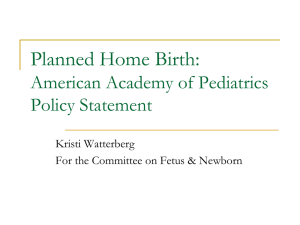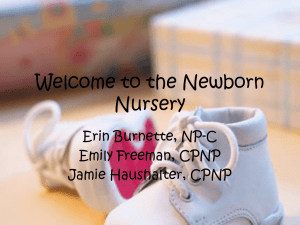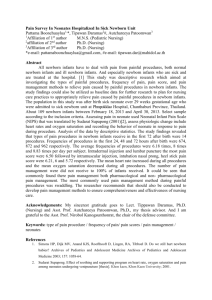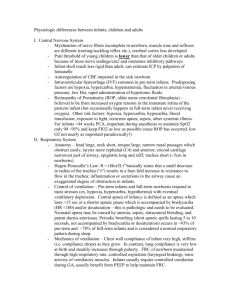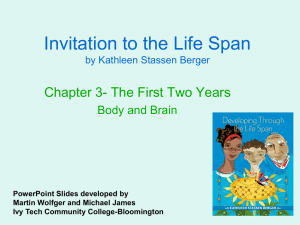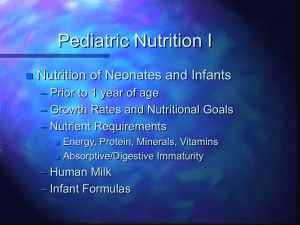Newborn Pearls-Evidence Based - Northeast Iowa Family Practice
advertisement
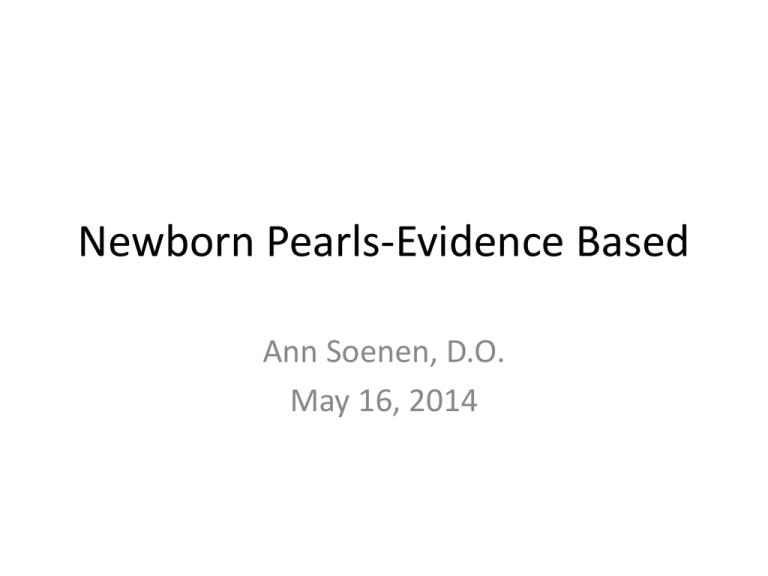
Newborn Pearls-Evidence Based Ann Soenen, D.O. May 16, 2014 Objectives • Become familiar with the Stanford online photo gallery • Recognize unique newborn exam findings • Formulate a treatment plan for these issues • Provide valuable instructions to the parents through use of a post-nursery discharge checklist • http://newborns.stanford.edu/PhotoGallery/ Gimme the vitals • Apgars – Know how to calculate • Temp – axilla of 36.1 to 37°C (97 to 98.6°F) in an open crib • HR – 120 to 160 • RR – 40 to 60 • BP – depends on gestational age, weight Apgars Newborn Hypertension? 40 weeks 50% 95% 99% SBP 80 95 100 DBP 50 65 70 MAP 60 75 80 SBP 77 92 97 DBP 50 65 70 MAP 59 74 79 SBP 72 87 92 DBP 50 65 70 MAP 57 72 77 38 weeks 36 weeks Newborn Skin Rashes-Birthmarks • • • • • CONGENITAL MELANOCYTIC NEVI DERMAL MELANOSIS HEMANGIOMAS NEVUS FLAMMEUS NEVUS SIMPLEX Newborn Skin Rashes- Common Rashes • Transient Vascular Phenomenon – CUTIS MARMORATA – HARLEQUIN COLOR CHANGE • • • • • • Erythema Toxicum Neonatorum Transient Neonatal Pustular Melanosis Acne Neonatorum Milia Miliaria (crystallina and rubra) Seborrheic Dermatitis Yellow? • Never normal in 1st 24 hours • Eyeball vs TcB vs TsB? – Visual assessment not as reliable – TcB not reliable during phototherapy, ?darkly pigmented skin – TcB can replace TB in most circumstances when TB is <15 mg/dL • Universal screening or Selective screening? • If intermediate-risk zone -> now what? Phototherapy • Plot the curve or online calculator- bilitool.org • NNT – It is estimated that 5 to 10 infants with TB between 15 and 20 mg/dL must receive phototherapy to prevent one patient from developing a TB >20 mg/dL. • Decline of TB at least 2 to 3 mg/dL within four to six hours – Result in 30-40% decrease in 24 hours • Additional evaluation or not? • Home Bili-blankets? For infants at low risk (≥38 weeks GA and without risk factors), phototherapy is started at the following TB values. 24 hours of age: >12 mg/dL 48 hours of age: >15 mg/dL 72 hours of age: >18 mg/dL Infants in this category who have TB levels 2 to 3 mg/dL below the recommended levels may be treated with fiberoptic or conventional phototherapy at home. Murmurs • Innocent or not? • Guess the problem? (Stanford audio file) Congenital Heart Disease • Didn’t you hear it? – Often Missed • CHD O2 screening (Lancet 2012-universal) – Postductal (NOT R arm) – SpO2 <95 % • Detection rate on prenatal ultrasound – Highly variable – Better if 4-chamber view w/ outflow tracts or fetal echo Head • The Abnormal Fontanel – Large anterior fontanel or delayed closure – Achondroplasia, Hypothyroidism, Down Syndrome, Rickets, Increased intracranial pressure • Caput vs cephalohematoma – When will it improve? • Subgaleal protocols • Craniosynostosis Red Reflex- now I see it now I don’t • Leukocoria – DDx: retinoblastoma, congenital cataract – How soon to see ophthalmology? • Darker pigmented skin? Dacro- what? • Dacryostenosis – Nasolacrimal duct obstruction, m/c cause of tearing in infants – Spontaneous resolution by 6 months in 90% – Tx: • Lacrimal cyst massage • Probing • Dacrocystocele or dacryocele or NLD cyst – Refer to opthalmology urgently • Dacrocystitis – Systemic antibiotics Tongue-Tied • History of Frenotomy for Ankyloglossia: • Popularity of casual frenotomy in the early 20th century • Procedure fraught with complications: bleeding, infection, scarring, "regenerating" • Fell into disrepute in the mid 20th century • Concurrent popularity of formula feeding • Older and recent text books claimed frenotomy unnecessary • Current resurgence of breastfeeding demands revisit of topic Frenotomy or Frenulectomy • Maternal complications- sore nipples • Infant complications- FTT • Pediatric complications- speech, orthodontic, social • Hazelbaker Assessment Tool for Lingual Frenulum Function • No anesthesia if performed under 3-4 months, can do in office Abdominal masses • Normal or not? – Diastasis recti • Umbilical hernia – Management • Umbilical cord – Single umbilical artery – Care & Normal detachment (in 1 wk) – Umbilical granuloma tx? Preauricular Skin tags/pits • Do all need screened for renal anomalies? • Screen for hearing impairment Extra digits • Polydactyly vs Syndactyly • Tie off or leave? • Associations? Newborn Foot • Metatarsus adductus – m/c, medial deviation forefoot – Most resolve, exercises, rare splinting • Positional calcaneovalgus feet (talipes calcaneovalgus) – hyperdorsiflexion of the foot with the abduction of the forefoot – Most resolve, exercises, splinting • Clubfoot (talipes equinovarus) – Most spontaneous, can be genetic – manipulation that includes casting and bracing (referred to as the Ponseti method V-finger Test Calcaneovalgus Clubfoot Sacral dimple • When do you need an ultrasound? – If visible intact base-> OK – If deep/large > 0.5cm, > 2.5cm from anus, or have tuft hair/vascular lesion -> Need u/s DDH-Click or Clunk? • Algorithm AAP • Exam (until age 2) – Ortolani and Barlow maneuvers – Galeazzi and Klisic signs • U/s use • Referral for tx – Triple diapers not recommended – Pavlik harness Screening for developmental hip dysplasia—clinical algorithm. Committee on Quality Improvement, Subcommittee on Developmental Dysplasia of the Hip Pediatrics 2000;105:896-905 ©2000 by American Academy of Pediatrics It’s a Boy or Girl? • Vaginal skin tags, discharge • Hydroceles vs inguinal hernias – transillumination • Undescended testicle – 2-5% at term – When to refer? • Hypospadias, epispadias • Ambiguous Gomco Circumcision Q’s • If don’t get circumcised- do they have to retract foreskin and clean? – No, just clean like rest of body • Potential Benefits • Potential complications • When to call urology? Discharge Instructions Properly feeding the infant Instruction on proper breastfeeding position, attachment, and adequacy of swallowing Discharge Checklist for Healthy Newborns Breastfeeding mothers should consult their physicians before taking any new medications. Parents should not give their infant supplemental water or honey. Breastfed and bottle-fed infants receiving less than 500 mL of formula per day should receive 200 IU of a vitamin D supplement per day. Urination patterns Six or more wet diapers per day is normal for a breastfed infant after the mother’s milk has come in, as well as for bottle-fed infants. Bowel movements More than three bowel movements per day is normal in breastfed infants. Bottle-fed infants may have fewer bowel movements. Umbilical cord care Instruction on proper cleaning Skin care Review of common rashes Genital care Instruction on proper care of circumcised or uncircumcised penises, as well as care of newborn girls’ genitals Signs of illness Rectal temperature of 100.5˚F (38˚C) or higher Signs of dehydration, lethargy, poor feeding Prevention of sudden infant death syndrome Instruction on properly positioning the infant for sleep Discharge Instructions, cont.. • Parental smoking cessation • Car seat selection and proper use See Table 2 • Follow-up appointment made at discharge Infants younger than 24 hours, follow up within 72 hours of age • Infants 24 to 48 hours of age, follow up within 96 hours of age • Infants older than 48 hours, follow up within 120 hours of age
